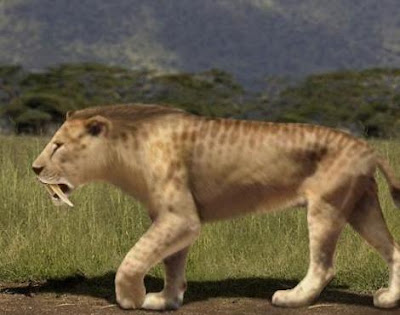Animals Unique | Sabre-toothed Tiger Unique | The saber-toothed tiger is one of the most well-known prehistoric animals along with giants Such as the Woolly mammoth. Sabre-toothed tigers roamed the mid-western U.S. and parts of both North and South America and were named for the enormous canines the which show skeletons, protruded quite far out of Their mouths.
Despite it's name, the saber-toothed tiger was not actually related to the modern tigers are found throughout That the jungles of Asia. It is thought the saber-toothed That tiger would have roamed across the plains and open woodlands Grassland throughout both North and South America where individuals would of varied slightly depending on the which They inhabited the area.
The saber-toothed tiger is one of the best known ice-age animals but little is really known about them as They are thought to have Become extinct around 10,000 BC the which is a long time ago. The saber-toothed tiger was named for the canines That Could grow to more than 7 inches in length and were capable of fatally wounding Their prey with one bite.
Sadly, the color of the saber-tooth tiger is unknown but it is thought That is would of been of a similar colouration to the modern day lion found in Africa (and the which it is not closely related to). The saber-toothed tiger also had a powerful, muscular body of the which Meant That Could Quickly catch it and pounce on it's prey before using it's knife-like teeth to cause to the fatal blow.
In the same way as modern day felines, saber-toothed tiger the was a Carnivorous animal and would of been the most dominant predator within its environment. Large herbivorous animals as deer and bison Such would of been the most common prey of the saber-toothed tiger along with occasional giant Such as a small Woolly mammoths Their ranges should cross, although exact Their diet is unknown.
In the same way as modern day felines, saber-toothed tiger the was a Carnivorous animal and would of been the most dominant predator within its environment. Large herbivorous animals as deer and bison Such would of been the most common prey of the saber-toothed tiger along with occasional giant Such as a small Woolly mammoths Their ranges should cross, although exact Their diet is unknown.
The saber-toothed cat would of been the most ferocious and therefore the apex predator within it's environment so had no natural predators on the American plains. Humans are thought to be the most Likely cause for the demise of this enormous cat and more than saber-toothed tiger 2.000 skeletons have been found in the tar pits emerged close to Los Angeles.
As with modern felines, saber-toothed tiger the would of Bred in the warmer months of early spring, when after a gestation period That Could last as long as 8 months, the female saber-toothed tiger would give birth to an average of 3 cubs per litter. Nothing is known about saber-toothed tiger cubs born but They Could be blind like the cubs of today's felines.
As with modern felines, saber-toothed tiger the would of Bred in the warmer months of early spring, when after a gestation period That Could last as long as 8 months, the female saber-toothed tiger would give birth to an average of 3 cubs per litter. Nothing is known about saber-toothed tiger cubs born but They Could be blind like the cubs of today's felines.
The saber-toothed tiger is thought to have Become extinct more than 12.000 years ago when human settlers first arrived in the Americas, hunting this species to extinction. Although climate change Could also be the primary cause for Their demise, however little is really known.
Sabre-toothed Tiger Unique Facts
Kingdom: Animalia
Phylum: Chordata
Class: mammals
Order: Carnivora
Family: Felidae
Genus: Smilodon
Scientific Name: Smilodon populator
Type: Mammal
Diet: Carnivore
Size (L): 2m - 2.5m (79in - 98in)
Weight: 300kg (661lbs)
Life Span: 20-40 years
Lifestyle: Pack
Conservation Status: Extinct
Extinct: 10,000 BC
Colour: Tan, Brown, Yellow, Black, White
Skin Type: Fur
Favourite Food: Deer
Habitat: Forests and grasslands
Average Litter Size: 3
Main Prey: Deer, Bison, Woolly Mammoth
Predators: Humans
Distinctive Features: Large muscular body and long canine teeth
Kingdom: Animalia
Phylum: Chordata
Class: mammals
Order: Carnivora
Family: Felidae
Genus: Smilodon
Scientific Name: Smilodon populator
Type: Mammal
Diet: Carnivore
Size (L): 2m - 2.5m (79in - 98in)
Weight: 300kg (661lbs)
Life Span: 20-40 years
Lifestyle: Pack
Conservation Status: Extinct
Extinct: 10,000 BC
Colour: Tan, Brown, Yellow, Black, White
Skin Type: Fur
Favourite Food: Deer
Habitat: Forests and grasslands
Average Litter Size: 3
Main Prey: Deer, Bison, Woolly Mammoth
Predators: Humans
Distinctive Features: Large muscular body and long canine teeth





No comments:
Post a Comment